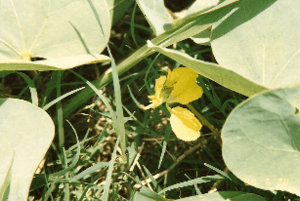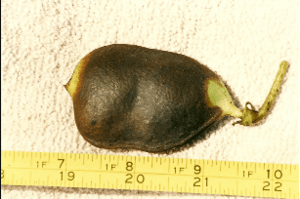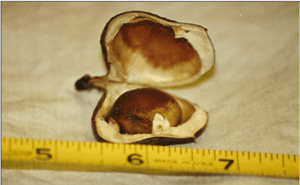Tylosema esculentum facts for kids
Quick facts for kids Tylosema esculentum |
|
|---|---|
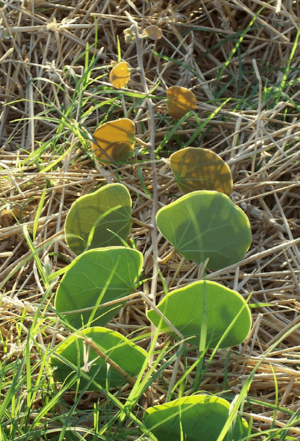 |
|
| Scientific classification | |
| Kingdom: | |
| (unranked): | |
| (unranked): | |
| (unranked): | |
| Order: | |
| Family: | |
| Subfamily: |
Cercidoideae
|
| Tribe: |
Bauhinieae
|
| Genus: |
Tylosema
|
| Species: |
T. esculentum
|
| Binomial name | |
| Tylosema esculentum (Burch.) A.Schreib.
|
|
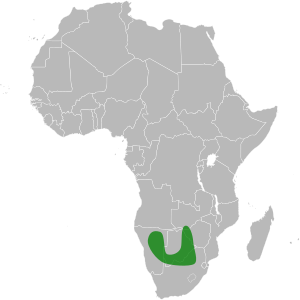 |
|
| The range of Tylosema esculentum. | |
| Synonyms | |
|
|
The Tylosema esculentum, also known as the gemsbok bean or marama bean, is a special plant from southern Africa. It's a type of legume, like a pea or bean plant, that lives for many years. It grows well in dry, desert-like areas.
This plant has long stems that can grow at least 3 meters (about 10 feet) along the ground or climb using special tendrils. It produces many yellow-orange flowers on a stalk. These flowers eventually turn into round or oval pods. Inside these pods are large, brownish-black seeds.
Contents
What is the Marama Bean Like?
The marama bean plant grows a lot in the summer, especially after its first year. This is thanks to its huge underground tuber, which is like a giant root. In its home countries like South Africa, Namibia, and Botswana, the plant rests during winter. But in places with milder winters, it might stay green all year.
The marama bean is perfect for dry places because it doesn't need much water. It can handle droughts very well. This means it could be grown in dry areas that aren't used for farming right now. Scientists are still checking if it can grow in different types of soil.
Amazing Nutrition from Marama Beans
The marama bean is super healthy, even though people haven't tried to improve it much yet. Its tubers are packed with protein (about 9%). For example, cassava tubers only have 1-3% protein, and yams have about 7%.
The seeds are even better, with 30-39% protein! They also have important building blocks called amino acids, like lysine and methionine. This means marama bean seeds have as much protein as common soybeans. So, marama beans could become a big source of protein in the future, especially if they are improved through breeding.
The underground tuber can grow incredibly large. Some have been found weighing over 10 kilograms (22 pounds). One tuber found in Botswana weighed a massive 277 kilograms (over 600 pounds)! The seeds grow inside large, squat pods, usually with one or two seeds per pod.
How People Use Marama Beans
The marama bean is a very important food for people living in the Kalahari Desert. Its large seeds are full of protein and oil. Each seed can weigh 20-30 grams (about an ounce).
People usually roast the seeds, which makes them taste like cashews or chestnuts. You can also grind them into flour or boil them. The seeds have a hard outer shell, which helps them stay fresh for a long time.
The tuber can also be eaten, but only from young plants (one or two years old). After that, the tuber becomes tough and doesn't taste as good.
Marama Bean Flour
The flour made from marama beans is another interesting product. It can be made from heated or unheated beans. This flour is rich in protein and could be a healthy ingredient in many foods. It's similar to flour made from soybeans. So, marama bean flour could be added to other flours, like cereal flours, to make them more nutritious.
Marama Milk
Marama milk is a creamy white drink made by soaking and processing the beans in water. It looks and tastes a lot like regular dairy milk or soymilk. It's a refreshing and healthy drink, but you can't buy it in stores yet.
Marama milk has high levels of sodium and iron compared to soymilk and dairy milk. However, it has less calcium.
To make marama milk, the beans are first heated (blanched or roasted). Then they are cracked and ground into a powder. This powder is mixed with water, boiled, and then filtered to get the milk.
Marama as Animal Food
The marama bean plant isn't just for people! Its leaves are also a good food source for farm animals and wild animals in Southern Africa. Animals enjoy eating the leaves. Since marama beans grow well in dry places, they could be used to feed animals in drier parts of Africa.
Growing marama beans for animal food also helps the soil. It keeps the soil moist and stops wind and water from washing it away. It also helps build up good stuff in the soil, which is great for soils that don't have many nutrients.
How Marama Beans Grow
The seeds of the marama bean have a very hard outer shell. Because of this, they need a special treatment called scarification to help them sprout. This treatment helps the seeds absorb water and start growing.
Like most legumes, marama beans prefer soil that is not too acidic or too basic (a neutral pH). They usually grow in very sandy soil, where water drains away easily. This prevents the roots from getting too wet and rotting. Even though many people around the world are interested in this plant, it's still a bit tricky to grow a lot of them.
The plant can grow outdoors in places as far north as Zone 8 in the United States. In winter, the parts of the plant above ground might die from freezing, but the plant grows back each spring. One challenge in growing marama beans for their seeds is that the pods take a long time to ripen, sometimes right up until the first hard freeze of the year.
Reproduction and Life Cycle
Interestingly, the marama bean and other plants in its group are special because they have different types of flowers. This is called heterostyly. This means that the plant has flowers with different arrangements of their male and female parts. This can make it harder for the plant to produce many seeds, which affects how much can be harvested.
Scientists have found that to get the best germination, you need to scratch or crack the hard seed coat with sandpaper. This is a type of mechanical scarification. Other ways to help the seeds sprout include soaking them in hot water or heating them dry.
The type of soil also matters. Marama beans grow best in sandy soil. Sandy soil has good properties that help the seeds sprout quickly, unlike clay soil which can hold too much water.
Pests and Problems
Sometimes, two types of fungi can infect the marama bean pods. These fungi, called Alternaria tenuissima and Phoma spp., cause dark spots on the pods. Insects can also cause damage to the seeds.
Marama Beans in Communities
The marama bean is a natural food source for communities in dry parts of Southern Africa. It's very important for people living in places with little rainfall. The plant can grow in these harsh, dry areas because its large tuber stores a lot of water and nutrients. This makes it a "drought-tolerant" crop.
Many families in Southern Africa grow marama beans locally. However, they might not know just how healthy these beans are. Studies have shown that marama bean seeds have high levels of fat (lipids) and protein, even more than other legumes. They also have a good amount of dietary fiber.
Because of its great nutrition, the marama bean can also be used to make oil, milk, and flour. Many families hope that marama beans will become more widely available in stores. This would help improve food security and offer more food choices for everyone.


